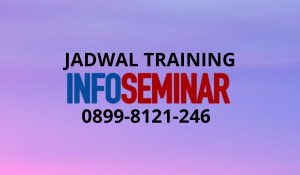LEADERSHIP ASSESSMENT USING MBTI
Tanggal
24-25 June 2010
Jam Pelaksanaan
09.00-17.00
Tempat
Hotel Ciputra
Pembicara
Fidelis Waruwu, M.Sc.
– MBTI Qualified Administrator ( CPP Mountain, California)
– Certified Trainer Personal Formation for Formators (Roma).
– Certified Trainer Living Values (Oxford).
CO-TRAINER :
Tohap P Simanjuntak
Harga
Rp 2.500.000/participant
Early Bird Rp.2.300.000 /participant , for payment received before June 15, 2010
Save Rp 750.000 for our previous participant in Expanded DiSC Training
10% Discount for 3 or more delegates from the same company
Fee Includes training material, meals and certificate
Materi
WHY THE MBTI
The Myers Briggs Type Indicator (MBTI) assessment is a popular and highly effective leadership assessment tool used by companies throughout the world
for discovering your individual strengths and styles, and also, learning about how you work with others.
It was developed by Isabel Briggs Myers and her mother Katharine Cook Briggs based on the work of Swiss psychiatrist Carl G. Jung.
BENEFITS
By attending The Myers Briggs Type Indicator (MBTI) workshop you will learn how to:
1. Improve interpersonal understanding, communication, teamwork, and the ability to work with or lead others.
2. Gain personal insight into your natural strengths and preferences
3. Improve the performance of teams
4. Develop more self-aware leaders
5. Motivate employees more effectively
6. Enhance group decision-making
7. Recognize and deal with stress
METHODOLOGY
This two-day program is both highly introspective and interactive utilizing a blend of activities designed to encourage reflection and lively interaction.
WORKSHOP OUTLINE
I. Development of Myers-Briggs Type Indicator
A. Concept of Type
1. Four main pairs.
2. What it does and does not measure.
B. Preference vs Behavior
1. What is most natural for us?
2. What is required of us?
II. Dimensions
A. How do you prefer to receive information?
1. Extraverted preference and its characteristics
Examples:
* Talks while processing information.
* Draws energy from the outer world.
* Enjoys spending time with many people.
2. Introverted preference and its characteristics
Examples:
* Processes information before talking.
* Draws energy from the inner world.
* Enjoys spending time alone or with a small group of people.
B. What form of information do you prefer?
1. Sensing preference and its characteristics
Examples:
* Examines tangible, concrete facts.
* Present-tense focus.
* Looks at details and facts.
2. Intuition preference and its characteristics
Examples:
* Listens to “gut” instincts.
* Future-tense focus.
* Looks at the overall picture and how things fit together.
C. On what basis do you prefer to make your decision?
1. Thinking preference and its characteristics
Examples:
* Attends to analysis and clarity.
* Can be seen as detached and cold.
* Concerned with what is objective.
2. Feeling preference and its characteristics
Examples:
* Concerned with a decision’s impact on people.
* Attends to what is right and wrong.
* Principles oriented.
D. How do you prefer to find and remind yourself of information?
1. Judging preference and its characteristics
Examples:
* Time oriented.
* Wants issues resolved.
* Does not like ambiguity.
2. Perceiving preference and its characteristics
Examples:
* Task oriented.
* More concerned with diagnosis than resolution of issues.
* Reviews decisions.
III. Type and Organizations
A. Decision Styles
1. Intuition – Thinking
“Theoretical” – Emphasis is with things in the future.
2. Intuition – Feeling
“Idealistic” – Emphasis is with people in the future.
3. Sensing – Thinking
“Practical” – Concern is with things in the present.
4. Sensing – Feeling
“Social” – Concern is with people in the present.
B. Strategy Styles
1. Intuition – Judging
“Planner” – Emphasis is with organizing the future.
2. Intuition – Perceiving
“Dreamer” – Emphasis is with flexibility in the future.
3. Sensing – Judging
“Organizer” – Concern is with organizing the present.
4. Sensing – Perceiving
“Troubleshooter” – Concern is with flexibility in the present.
C. Management Styles
1. Combined decision and strategy styles.
2. Efficient vs. Effective.
3. Comparing individual, departmental, and organizational preferences.
a. Complementary modes.
b. Potential blind spots.
TARGET PARTICIPANTS:
Managers , Supervisors and Team Leaders







